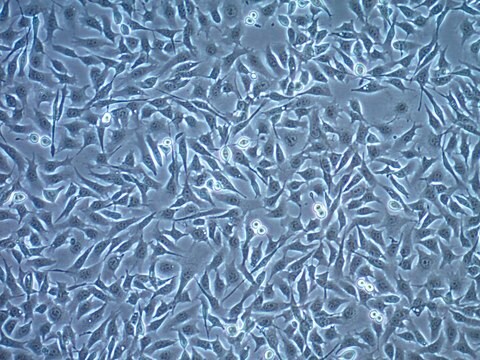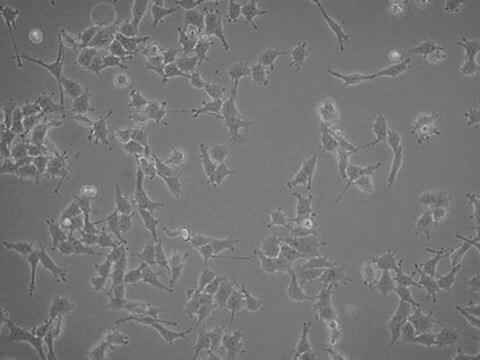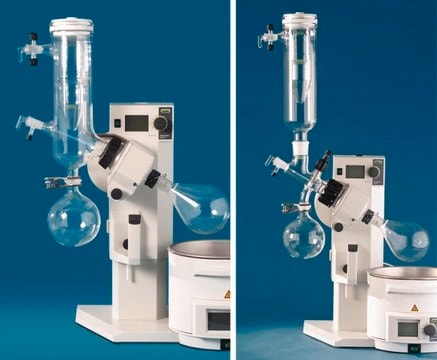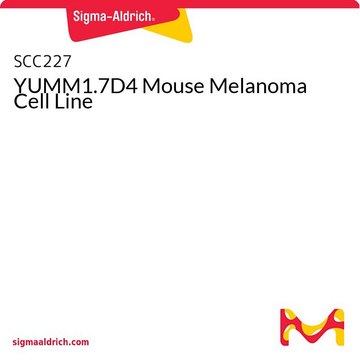SCC191
Linia komórkowa czerniaka myszy YUMM1.7
Zaloguj sięWyświetlanie cen organizacyjnych i kontraktowych
About This Item
Kod UNSPSC:
41106514
eCl@ss:
32011203
NACRES:
NA.45
Polecane produkty
opis
Cell line type: Cancer Cells
metody
cell culture | mammalian: suitable
Opis ogólny
Ogromne nadzieje związane z terapiami immunologicznymi w leczeniu nowotworów i niedawne postępy w skutecznym stosowaniu tych metod sprawiły, że na pierwszy plan wysunęła się konieczność stosowania modeli immunokompetentnych do oceny odpowiedzi układu odpornościowego na komórki nowotworowe. Immunokompetentne, genetycznie zmodyfikowane modele mysie, zawierające dyskretne czynniki genetyczne czerniaka, są niezbędne do badania potencjalnych immunoterapii, ale są ograniczone potrzebą utrzymywania kolonii wielu genotypów niezbędnych do generowania modeli myszy o odpowiednim tle genetycznym.
Linia komórkowa czerniaka myszy YUMM1.7 została opracowana jako immunokompetentna linia komórkowa, która odzwierciedla czynniki genetyczne występujące w znacznej części czerniaków u ludzi (1). Komórki YUMM1.7 są syngeniczne z immunokompetentnym tłem myszy C57/B1/6 i zachowują markery genetyczne mysiego modelu Braf/Pten, charakteryzującego się aktywacją Braf i inaktywacją Pten i Cdkn2a, w którym guzy czerniaka rozwijają się z krótkim opóźnieniem (2). Komórki YUMM1.7 są wysoce nowotworowe in vivo (1). Linia komórkowa mysiego czerniaka YUMM1.7 stanowi cenne narzędzie dla immunologii nowotworów i biologii raka, szczególnie podatne na ocenę i generowanie nowych immunoterapii.
Odniesienia:
1. Meeth K et al. (2016) Linie YUMM: seria kongenicznych mysich linii komórkowych czerniaka ze zdefiniowanymi zmianami genetycznymi. Pigment Cell Melanoma Res 29(5): 590-597.
2. Dankort D et al. (2009) Braf(V600E) współpracuje z utratą Pten w celu wywołania przerzutowego czerniaka. Nat Genet. 41(5): 544-552.
Linia komórkowa czerniaka myszy YUMM1.7 została opracowana jako immunokompetentna linia komórkowa, która odzwierciedla czynniki genetyczne występujące w znacznej części czerniaków u ludzi (1). Komórki YUMM1.7 są syngeniczne z immunokompetentnym tłem myszy C57/B1/6 i zachowują markery genetyczne mysiego modelu Braf/Pten, charakteryzującego się aktywacją Braf i inaktywacją Pten i Cdkn2a, w którym guzy czerniaka rozwijają się z krótkim opóźnieniem (2). Komórki YUMM1.7 są wysoce nowotworowe in vivo (1). Linia komórkowa mysiego czerniaka YUMM1.7 stanowi cenne narzędzie dla immunologii nowotworów i biologii raka, szczególnie podatne na ocenę i generowanie nowych immunoterapii.
Odniesienia:
1. Meeth K et al. (2016) Linie YUMM: seria kongenicznych mysich linii komórkowych czerniaka ze zdefiniowanymi zmianami genetycznymi. Pigment Cell Melanoma Res 29(5): 590-597.
2. Dankort D et al. (2009) Braf(V600E) współpracuje z utratą Pten w celu wywołania przerzutowego czerniaka. Nat Genet. 41(5): 544-552.
Źródło:
Linia komórkowa czerniaka myszy YUMM1.7 została wyprowadzona z guza czerniaka indukowanego 4-hydroksytamoksyfenem u samca myszy C57/B1/6, do którego wprowadzono mutacje z genetycznie modyfikowanego modelu myszy Braf/Pten poprzez krzyżowanie wsteczne. Linia komórkowa YUMM1.7 jest nosicielem mutacji Braf V600E i jest homozygotycznie ujemna dla dzikiego typu Pten i Cdkn2 (1).
Linia komórkowa czerniaka myszy YUMM1.7 została wyprowadzona z guza czerniaka indukowanego 4-hydroksytamoksyfenem u samca myszy C57/B1/6, do którego wprowadzono mutacje z genetycznie modyfikowanego modelu myszy Braf/Pten poprzez krzyżowanie wsteczne. Linia komórkowa YUMM1.7 jest nosicielem mutacji Braf V600E i jest homozygotycznie ujemna dla dzikiego typu Pten i Cdkn2 (1).
Zastosowanie
Niniejszy produkt jest przeznaczony do sprzedaży i sprzedawany wyłącznie instytucjom akademickim do wewnętrznego użytku akademickiego zgodnie z warunkami "Umowy o użytkowaniu akademickim", jak wyszczególniono w dokumentacji produktu. Aby uzyskać informacje na temat innych zastosowań, prosimy o kontakt pod adresem licensing@emdmillipore.com.
Jakość
- Each vial contains >=1X106 viable cells.
- Cells are tested negative for infectious diseases by a Human Essential CLEAR panel by Charles River Animal Diagnostic Services.
- Cells are verified to be of human origin and negative for inter-species contamination from rat, mouse, chinese hamster, Golden Syrian hamster, and non-human primate (NHP) as assessed by a Contamination CLEAR panel by Charles River Animal Diagnostic Services.
- Cells are negative for mycoplasma contamination.
- Each lot of cells is genotyped by STR analysis to verify the unique identity of the cell line.
Przechowywanie i stabilność
Przechowywać w ciekłym azocie. Komórki mogą być hodowane przez co najmniej 10 pasaży po wstępnym rozmrożeniu bez znaczącego wpływu na ekspresję markerów komórkowych i ich funkcjonalność.
Oświadczenie o zrzeczeniu się odpowiedzialności
Ten produkt zawiera organizmy zmodyfikowane genetycznie (GMO). W UE GMO są regulowane odpowiednio dyrektywami 2001/18/WE i 2009/41/WE Parlamentu Europejskiego i Rady oraz ich krajową implementacją w państwach członkowskich. Przepisy te zobowiązują {HCompany} do żądania pewnych informacji o użytkowniku i zakładzie, w którym przetwarzane są GMO. Kliknij tutaj, aby wyświetlić formularz deklaracji użytkownika końcowego (EUD).O ile nie określono inaczej w naszym katalogu lub innej dokumentacji firmy dołączonej do produktu(ów), nasze produkty są przeznaczone wyłącznie do użytku badawczego i nie mogą być wykorzystywane do żadnych innych celów, w tym między innymi do nieautoryzowanych zastosowań komercyjnych, zastosowań diagnostycznych in vitro, zastosowań terapeutycznych ex vivo lub in vivo ani do żadnego rodzaju konsumpcji lub stosowania u ludzi lub zwierząt.
Ta strona może zawierać tekst przetłumaczony maszynowo.
Kod klasy składowania
12 - Non Combustible Liquids
Klasa zagrożenia wodnego (WGK)
WGK 1
Temperatura zapłonu (°F)
Not applicable
Temperatura zapłonu (°C)
Not applicable
Certyfikaty analizy (CoA)
Poszukaj Certyfikaty analizy (CoA), wpisując numer partii/serii produktów. Numery serii i partii można znaleźć na etykiecie produktu po słowach „seria” lub „partia”.
Masz już ten produkt?
Dokumenty związane z niedawno zakupionymi produktami zostały zamieszczone w Bibliotece dokumentów.
Nasz zespół naukowców ma doświadczenie we wszystkich obszarach badań, w tym w naukach przyrodniczych, materiałoznawstwie, syntezie chemicznej, chromatografii, analityce i wielu innych dziedzinach.
Skontaktuj się z zespołem ds. pomocy technicznej





